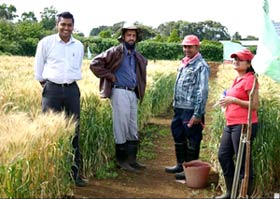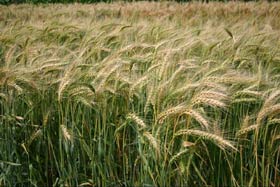CIMMYT E-News, vol 5 no. 10, October 2008
 As the price of wheat goes up, countries such as the Republic of Mauritius are feeling the pinch. A former British colony off the coast of Madagascar, it imports most of its wheat from France and Australia. But with help from CIMMYT, the island has started trials to grow its own wheat—and results to date look promising.
As the price of wheat goes up, countries such as the Republic of Mauritius are feeling the pinch. A former British colony off the coast of Madagascar, it imports most of its wheat from France and Australia. But with help from CIMMYT, the island has started trials to grow its own wheat—and results to date look promising.
The CIMMYT germplasm bank freely distributes maize and wheat seed to hundreds of partners worldwide each year. In January 2008, Tom Payne, Head of CIMMYT’s wheat germplasm bank (seed bank), received a request for wheat seed from Mala Gungadurdoss, Head of the Mauritanian Agronomy Department at the Ministry of Agro-industry. “The rising price of imported wheat coupled with a scarcity on the international market (made us) revisit our food and agricultural policy,” explains Gungadurdoss, who is also Principle Research Scientist of the Agricultural Research and Extension Unit. “Our food security is at stake, since Mauritius imports most of its staples.”
Payne sent a “yield trial” of 49 elite spring wheat lines that he thought might flourish in the climactic conditions and disease spectrum of the island. “In a way, it’s kind of an exploratory experiment,” he says. “I don’t really know their environment and they don’t really know wheat, so I sent them something to see if it fit their conditions.”
Payne’s selection was apparently successful. “I am really satisfied with the yields of above 5 tons per hectare for 13 of the lines,” says Gungadurdoss. “I consider these yields to be very good when I compare them to yields of 1.5-3 tons per hectare obtained in the trials of 1985-1993,” referring to the last period during which the country grew wheat trials. Gungadurdoss admits that recent conditions were conducive to achieving good yields; but the highest yields for this year’s trial ranging from 5.8 to 6.4 tons per hectare are not only vastly superior to the results of previous trials; they are more than twice wheat’s global average of 2.5 tons per hectare.
Wheat’s roots in Mauritius
The Dutch introduced wheat to Mauritius in 1598 and it was grown on a commercial scale in the 1820s. But only about 1,700 hectares were under cultivation by the end of the 1930s, when the island began focusing on growing the more profitable sugarcane and importing wheat, which was far less expensive to buy, according to Gungadurdoss. “Up until three years ago, wheat was very cheap,” says Payne. “It was overproduced in Europe, North America, and Australia. This is one of the reasons the price of wheat and other grains stayed low for long time.”
Most people who live on Mauritius are of Indian origin and eat food staples such as chappatis, pharatas, puris, and bread made from wheat and wheat flour, says Gungadurdoss. In 2007 the island imported around 140,000 tons of unmilled wheat and 9,000 tons of flour. Over the last 5 years the country imported an average of 137,000 tons of unmilled wheat and 9,500 tons of wheat flour costing USD 28 million. The per capita consumption of wheat flour averaged 74 kilograms per year, and this is expected to increase in the future, according to Gungadurdoss.

Thanks to the wheat breeding lines sent by CIMMYT, agronomists on Mauritius can screen promising wheat lines for high grain yield, early maturity, resistance to major pests and diseases, and good baking characteristics; assess wheat’s economic feasibility under local conditions; identify the main constraints to production and devise corrective measures; and conserve their own elite germplasm (seeds and genetic material).
“Based on whatever results the agronomists from Mauritius send us, we can send them more lines from CIMMYT’s wheat germplasm bank and international nurseries,” says Payne. “These lines will have much broader genetic variation and will be even better suited for the island.”
Homegrown wheat could be within reach
For now, growing wheat in Mauritius is still in the early stages; sowing, weeding, harvesting, threshing and winnowing were done manually at Réduit Crop Research Station. One of the next steps will be to research the economic viability of growing and processing wheat using mechanization which will be tested on a much larger scale, possibly with interested farmers in 2009, according to Gungadurdoss.
“Once the economic feasibility is determined, we can decide on our future move: maybe large-scale production in line with cross border initiatives with Madagascar or Mozambique to substitute part of our imports can be considered.”
“I think Mauritius gets enough rainfall for wheat, and it’s on roughly the same latitude as countries or regions that get good yields, such as Uruguay, Zimbabwe, and northern Mexico, so high wheat yields should definitely be possible,” says Hans-Joachim Braun, Director of CIMMYT’s Global Wheat Program.
For more information: Tom Payne, Head, Wheat Germplasm Bank (t.payne@cgiar.org)
More stories on agriculture in Mauritius (both in French)
Mala Gungadurdoss (Areu) : «Du riz et du blé Made in Mauritius, c’est possible»
 Climate adaptation and mitigation
Climate adaptation and mitigation